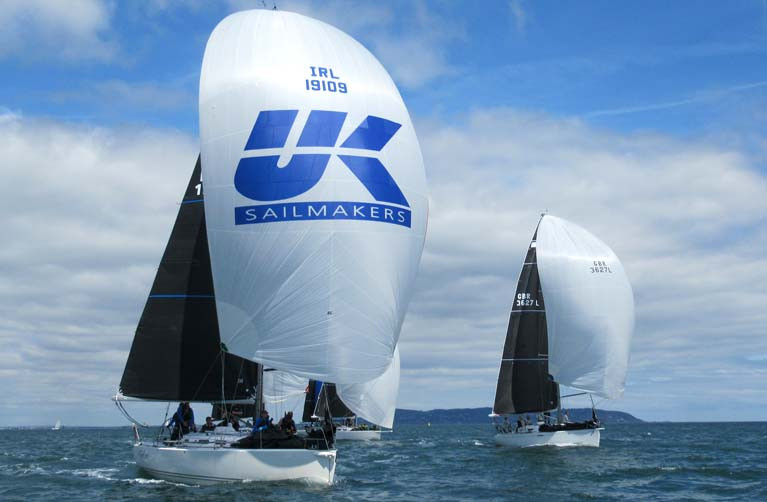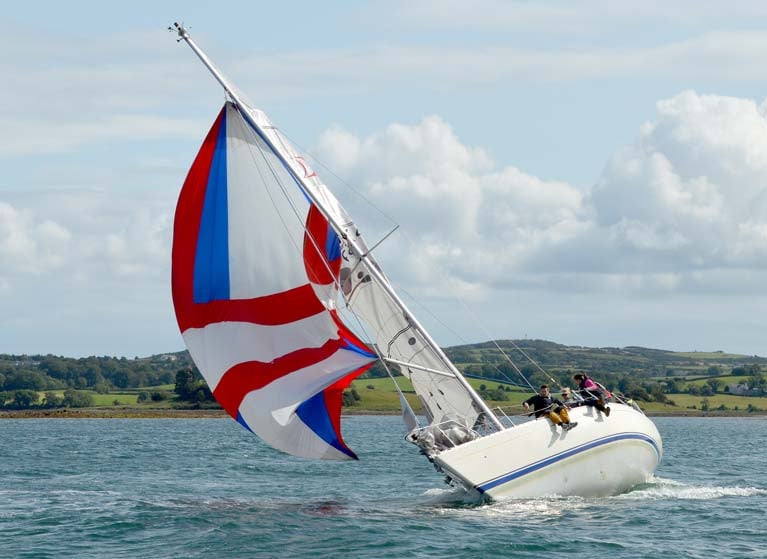Displaying items by tag: Spinnaker
Symmetric Versus Asymmetric Spinnaker in IRC: What’s Best & Why?
Barry Hayes of UK Sailmakers Ireland goes through the different options for racing boats going 'Symmetrical' or 'Asymmetrical' with their spinnakers. What’s best and why?
In the past 15 years, spinnaker options have increased considerably. Prior to that, it was fairly straightforward. You bought a light air symmetric spinnaker, a heavy air version of the same, and maybe a reaching spinnaker. In recent years, however, asymmetric spinnakers have become a lot more efficient and some yacht builders, particularly J Boats, feature them almost exclusively on their models.
The following is an analysis of which option is better for racing inshore/offshore.
First the pros and cons of each option:
Asymmetric Spinnakers
Pros
- Easier trimmed and handled
- IRC rating allows larger asymmetric spinnakers for the same rating, relative to symmetric spinnakers
- Very efficient when reaching as the shape allows better exhaust of the air across the leeward side of the mainsail.
- Code zero models (very flat asymmetrics for close reaching) is a must for offshore boats
Cons
- Needs a sprit or prodder to set them properly away from the bow.
- They don’t run as deep and efficiently as symmetric spinnakers.
- In heavy air, they sometimes can wrap around the forestay when gybing
- Time is always lost gybing, compared to boats with poles
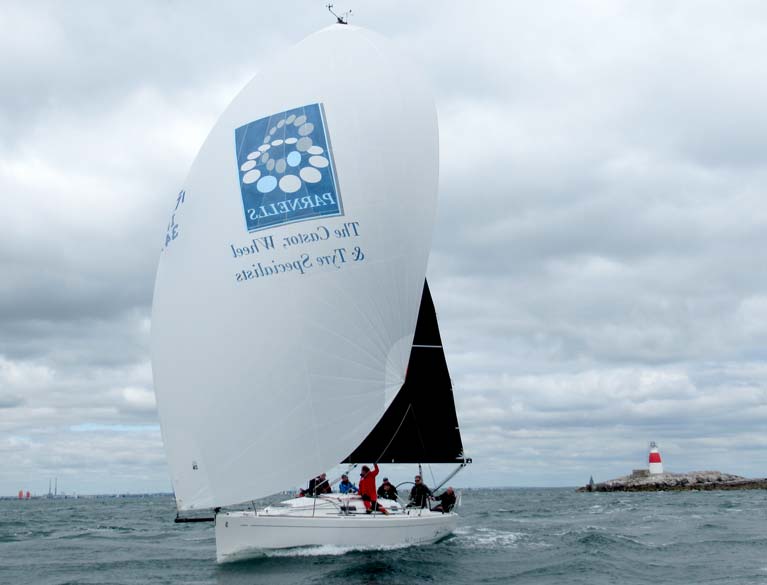 First 34.7 Black Velvet
First 34.7 Black Velvet
Symmetric Spinnakers
Pros
- Once above 12 knots, they are very efficient running with pole pulled back.
- Tactically, they offer an experienced crew greater options downwind.
- Very little time lost while gybing.
Cons
- Expensive on IRC rating – On a J/109, converting to a symmetric costs about 7 points if you want the same sized spinnaker
- Not as efficient when reaching due to shape
- More difficult to hoist and trim properly
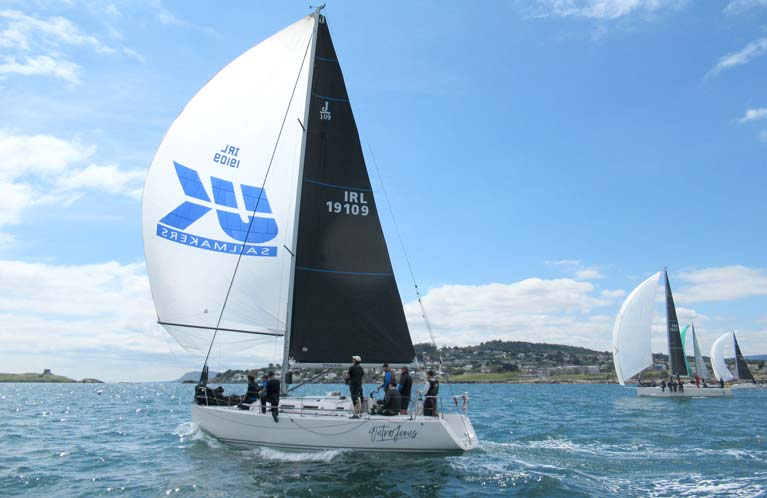 The J109 Outrageous
The J109 Outrageous
At UK Sailmakers Ireland, we had a J/109 client that opted to go for symmetric spinnakers on a boat that is designed for A-sails. Before we went down this route, we did extensive testing and trial certs to see what the benefits would be. We found that there is no perfect answer. If you were able to have two IRC certificates (one symmetric, one asymmetric), and be able to select which one, each race, then you would have both set-ups.
However, IRC does not allow this, and most regattas insist you don’t change your cert in the last 10 days before a regatta, as long-range weather forecast details may play a part in your decision.
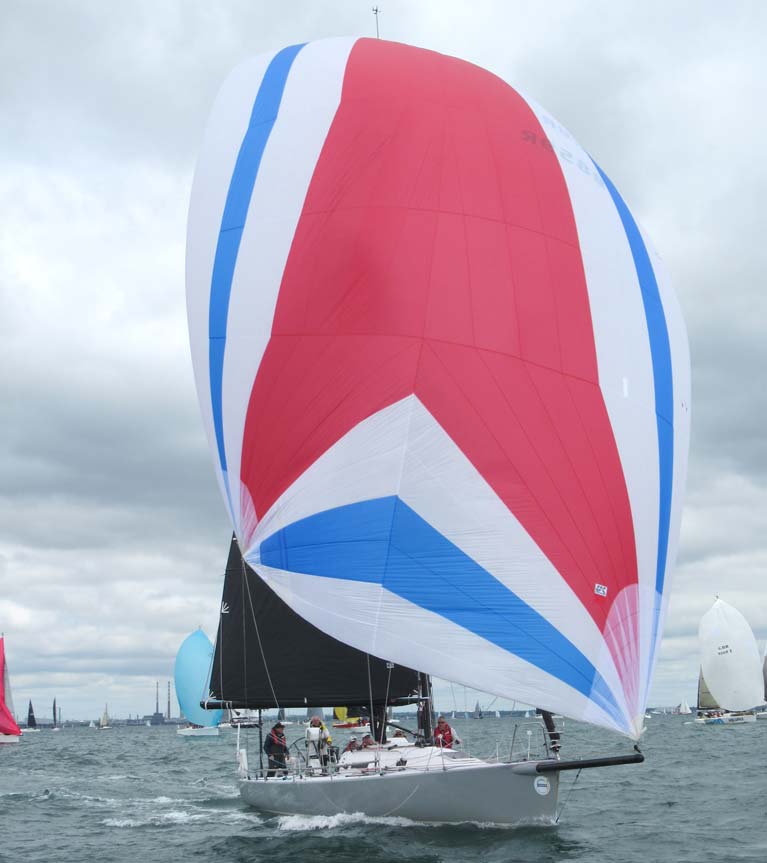 Andrew Hall's Jackknife
Andrew Hall's Jackknife
A-sails are generally more efficient on normal cruisers in less than 12 knots than symmetric spinnakers. Why?
Up to 12 knots, most symmetric boats struggle to get their spinnaker poles back far enough, as the spinnaker will collapse. So, an A2 asymmetric boat will likely be able to run as deep as an S2 symmetric boat, but the A2 asymmetric usually will have a larger spinnaker area and a lower rating. IRC, it appears, penalises a boat with a pole by about seven points (on a J/109), for the ability to be able to pull the pole back and go deep.
In light airs, if you can’t get the pole back, then you are at a disadvantage. Add to that, an asymmetric sail is more efficient going at higher angles compared to boats with symmetric spinnakers.
Symmetric spinnakers are more efficient running in more than 14 knots. Why?
Once a symmetric boat can get its pole fully back, it can normally nearly run square, or maybe 10 degrees off square. A similar designed boat with an asymmetric spinnaker will likely go the same speed but be 10 degrees or higher. When the two boats get to the bottom mark, the symmetric boat has likely pulled out 30 to 60 seconds. Add to this, the symmetric boat can throw in gybes easily to stay in wind or get away from other boats' wind shadows, and the gain becomes even larger. If the wind gets up to 20 knots or more running, the symmetric boats have an even bigger advantage.
 Paul O'Higgins' JPK 10.80 Rockabill VI
Paul O'Higgins' JPK 10.80 Rockabill VI
Asymmetric boats are generally more efficient offshore and on Coastal racing
This is because the two scenarios above relate to running square downwind, as you would have in Windward Leeward racing. On offshore and coastal races, often there is a lot of reaching and broad reaching. The A sail boats then have their rating advantage, and the efficiency of the A sail when reaching.
What are the crewing considerations?
Trimming a symmetric spinnaker is considerably more difficult to do well, than trimming an Asymmetric spinnaker. A symmetric spinnaker needs the sheet adjusted constantly, the guy adjusting the angle of the pole is constantly being adjusted, as is the pole height and the spinnaker tweaker.
On an Asymmetric sail, it is generally just the A sail sheet that is adjusted. You may move the tackline up and down, but not that much. As a result, to get the best out of a symmetrical spinnaker, more good crew are needed to trim it well.
What about boats having both sail setups?
Any boat opting for a symmetric setup should also be planning to take some Asymmetric spinnakers as well. To do this efficiently, it needs a small sprit or prodder, to use with the A-sail for reaching conditions. The IRC rule allows a prodder (or sprit) on a symmetrically configured boat, as long as the prodder does not extend out further than the pole does.
However, the A sail size (SPA) on these A sails cannot be any bigger than the largest symmetric spinnaker. So in the case of our J109 which went Symmetric, we opted for a 102 sq. metre Symmetric spinnaker, which is six sq metres smaller than the Class A sail size. This saved two points off the rating, so the seven-point hit for the pole was lessened to five points overall. The new A sails added, to cover her reaching requirements were a code 0 for light air reaching and an AO, for light air running. The AO can be used off the prodder, or can also be transferred to a lowered pole, with the pole being pulled back to allow further depth.
 In these photos, you can see the Warship 36 using both the pole (above) and Asym set up (below) with her UK Sails A0 and S2 spinnaker
In these photos, you can see the Warship 36 using both the pole (above) and Asym set up (below) with her UK Sails A0 and S2 spinnaker
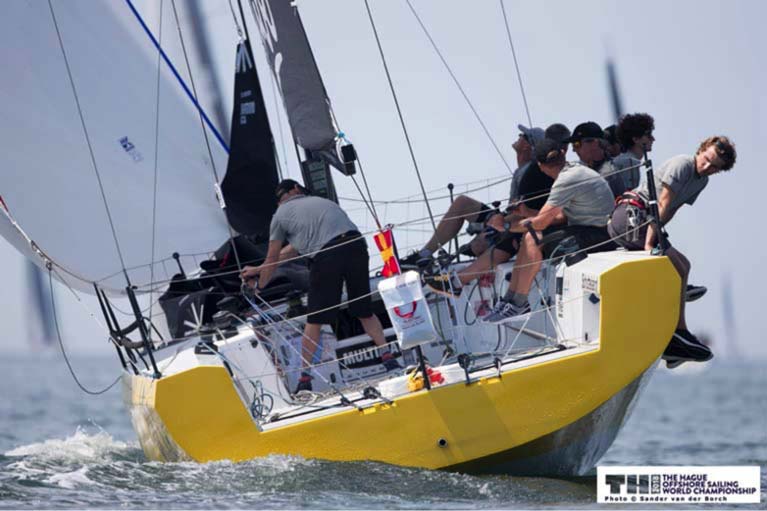
Cost Considerations
For an existing Symmetrical boat, changing to No pole and just using A sails would require,
- A sprit
- New Spinnaker specific A sail sheets
- New Asymmetrical spinnakers
- A tack line to attach the A sail to the Sprit
For an existing A sailboat, to go to symmetrical configuration requires,
- A pole
- A track on the mast
- additional Blocks etc. to cover sheets and guys and pole downhaul
- Symmetrical spinnakers and perhaps some A sails as well.
For someone ordering a new boat—it is best to try and incorporate both options from day one, even if only opting for one setup.
So, which option to go for?
As I said in my opening paragraph, there is no perfect choice, but here is a quick plan:
- For Light planing boats - Go A sail, as you will always be going higher angles
- For short-handed - A sail is a lot easier for Handling
- For Offshore/Coastal - A sail will likely be best, as more reaching than running
- For Inshore, in lighter air areas, go A-sail
- For Inshore in stronger wind areas - go Symmetric
- For Inshore in mixed conditions - Either works, but Symmetric with a good crew might just have the edge if you also have some good A sail options as well.
Sailing with a Spinnaker & Living on the Edge!
The yacht pictured above this week is definitely not aground, though it is at a critical angle.
It is a Sigma 33 racing at Quoile Yacht Club on Strangford Lough.
“We do have these interesting moments with spinnakers on these boats. This boat is definitely not aground,” says Peter Mullan in response to my recent Podcast about spinnakers and my own Sigma 33 experience. “You have a somewhat reluctant view of the glory of kites” and “that’s a lot of aversion to spinnakers” were amongst responses.
There are certainly mixed views about spinnakers, though “there is no doubting the “enjoyment and thrill they give, living on the edge, it’s great!” said another Email.
Peter Mullan’s photo recalled for me other moments with a spinnaker flying.
"there is no doubting the “enjoyment and thrill they give, living on the edge"
Off-watch in my bunk on the West Coast aboard John Killeen’s 44ft. ‘Mayhem’ out of Galway Bay Sailing Club in the Round Ireland Race. As she rose to a wave with the kite up there would be a great cheer from the Galwegians I was sailing with as Mayhem raced forwards, downwards it seemed to me braced in the bunk, then poised or shuddered, which was my impression of the moment as she picked up, the spinnaker gave her more power and she was away again, the Galwegians repeating the process time and again!
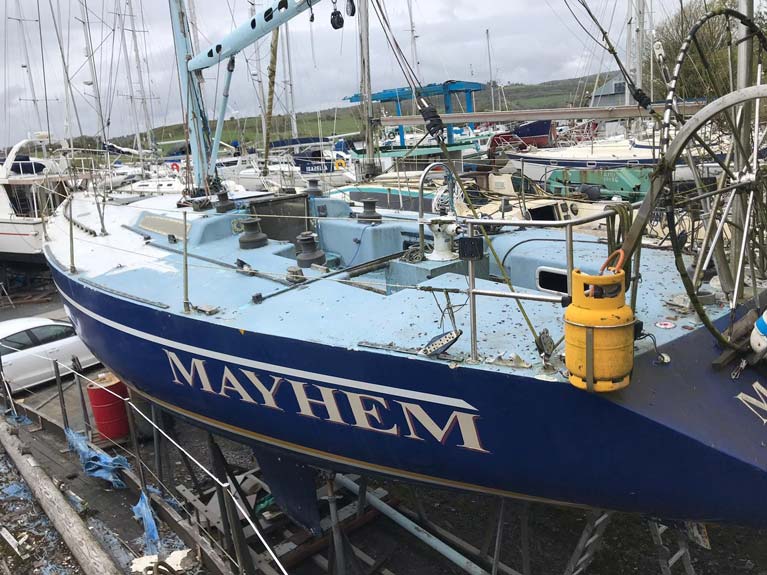 Mayhem, a Doug Peterson 40 of 1981 vintage
Mayhem, a Doug Peterson 40 of 1981 vintage
I’ve been trying to trace the origins of spinnakers, about which there seem to be several views. The origins of the name are lost in time, it seems to me.
There is one view that the spinnaker, described as “the colourful sail that can lead to equal amounts of delight and dread onboard yachts,” was first carried by a yacht in Cowes, off the Isle of Wight called Sphinx, or in some places named as ‘Spinx’ and that this new style of sail was then set in the Solent. That is contradicted by claims that the first boat to use a spinnaker was Niobe, owned by William Gordon and that one of his crew when they saw it said the sail would “make the boat spin” and so it became known as a spinnaker and William was called “Spinnaker Gordon”.
But then, Thames sailing barges used the term spinnaker for their jib staysails.
So, there’s no clear agreement about the origins.
There were spinnakers from Code Zero upwards on yachts that I have sailed on …. which took plenty of grabbing to get them down and even falling on top of at times in high winds to smother as they whirled like dancing dervishes about the bow`. And I remember the regular warning shout from the deck of NCB Ireland as we raced across the Atlantic in the Whitbread Round the World Race when the spinnaker was downed and, in your bunk you’d hear a shout as it was dumped down the hatch, spray often flying everywhere, followed by bodies grabbing it to rebag and ready it for the next launch. I remember it well as I learned how to bag the kite quickly and pray that when it went up again it was without a twist!
And I still remember those whoops of the Mayhem crew which convinced me that sailing on the West Coast was an “entirely different process.”
Eleven Races in Busy Irish Sea Offshore Schedule
Chairman of ISORA Peter Ryan sets out the 2011 programme for ISORA that kicks off on April 7th with an introductory evening on April 7th.
Spring has come and the days are getting longer. It is now time to be thinking about offshore racing again. The first race is on the 30th April from Dun Laoghaire to Holyhead.
I attach again the latest Race Schedule, Notice of Race, Conditions and Entry Form for 2011. I also attach details of the proposed "Offshore Introduction" night for offshore racing on the 7th April. Even if you are experienced, you can add to the proceedings or just come for the reception after.
There is an extensive list of eleven races in the schedule. The types of race vary greatly to give a variety of racing experiences. There are Day Races, Night Races, Short Cross Channel Races, Medium Cross Channel Races, 100 mile Lyver Trophy Race and "The Dingle Skellig Hotel D2D" – Dingle Race. There is racing for IRC, IRC No Spinnaker and 2-handed classes.
This season, if the number of entries permits, we will be running a Classic Class in both Class 1 & 2. The boats eligible for the Classic Classes will be selected by the Sailing Committee before the start of the first race and the selection will be based on the boats performance / capability during the previous season. It is hoped that this will provide a much greater spread of prizes. The rating break for Class 1 and Class 2 will be decided at the same time.
The Race schedule has been carefully selected to ensure the maximum amount of sailing and social life is obtained. The usual "get together" will take place before and after each race. This season we have some additional attractions:
If desired, the race on the 28th May from Pwllheli to Wicklow can be followed by boats taking part in the "Turbine Race" (see www.arklowsc.com on Sunday 29th. This race starts and finishes in Arklow, 10 miles from Wicklow. This will allow the usual "get together" in Wicklow on Saturday evening and another one in Arklow on Sunday after the Turbine Race. This is the UK Bank Holiday weekend and will allow the UK boats time to return home on Monday!
After taking part in the "Dingle Skellig Hotel D2D Dingle Race" on the 11th June. Please note that a second separate entry to the NYC is required if taking part in this race in the series. After a few relaxing nights in Dingle, you can wander around to take part in the "ICRA Championships" in Crosshaven before making your way to Kinsale for the "Sovereign's Cup". The Dingle Race is a qulaifier race for the Fastnet Race.
The Lyver Race on the 1st July is a Feeder Race to the Volvo Dun Laoghaire Regatta from the 7th-10th July – a great few days sailing in Dublin Bay. This race is a RORC qualifier for the Fastnet Race. Again, seperate entry is required for the Liverpool Yacht Club sections of the event.
The Sunday Race on the 14th August will take place directly after the start of the Solitaire du Figaro fleet from Dun Laoghaire. If possible we will set a course to follow the fleet down the coast. For visiting boats to Dun Laoghaire, the Figaro fleet will arrive in Dun Laoghaire on the Wednesday 10th August and there will be a festival in Dun Laoghaire for the couple of days to celebrate the event. There will be great craic in Dun Laoghaire for those days.
You may not have noticed but the ISORA website www.isora.org has been upgraded and will become very active this year. There is a "Crew Register" and a "Buy and Sell" section in the "Forum" page. I would encourage everyone to register for this facility and use it to get crew for races or for crew to get boats. Try the website out.
The "ISORA Introductory Evening" in the NYC on the 7th April. The purpose of this is to encourage those boats who are thinking of taking part in Offshore Racing by a series of talks about what is involved in this type of racing. I will also use this session to demonstrate the use of the new website's "Crew Register". I also hope to issue detailed instructions by email on the use of this facility. The session will be followed by a reception where people can solialise and relax. "Prof" O'Connell and Mick Liddy will be talking at the event. I will also be encouraging participation from the audience. It will be a great night so please come and bring a friend.
I look forward to receiving your entries very soon. I would appreciate it if you could also spread the good news about ISORA and Offshore Racing.


























